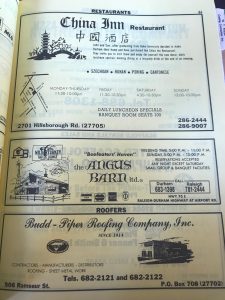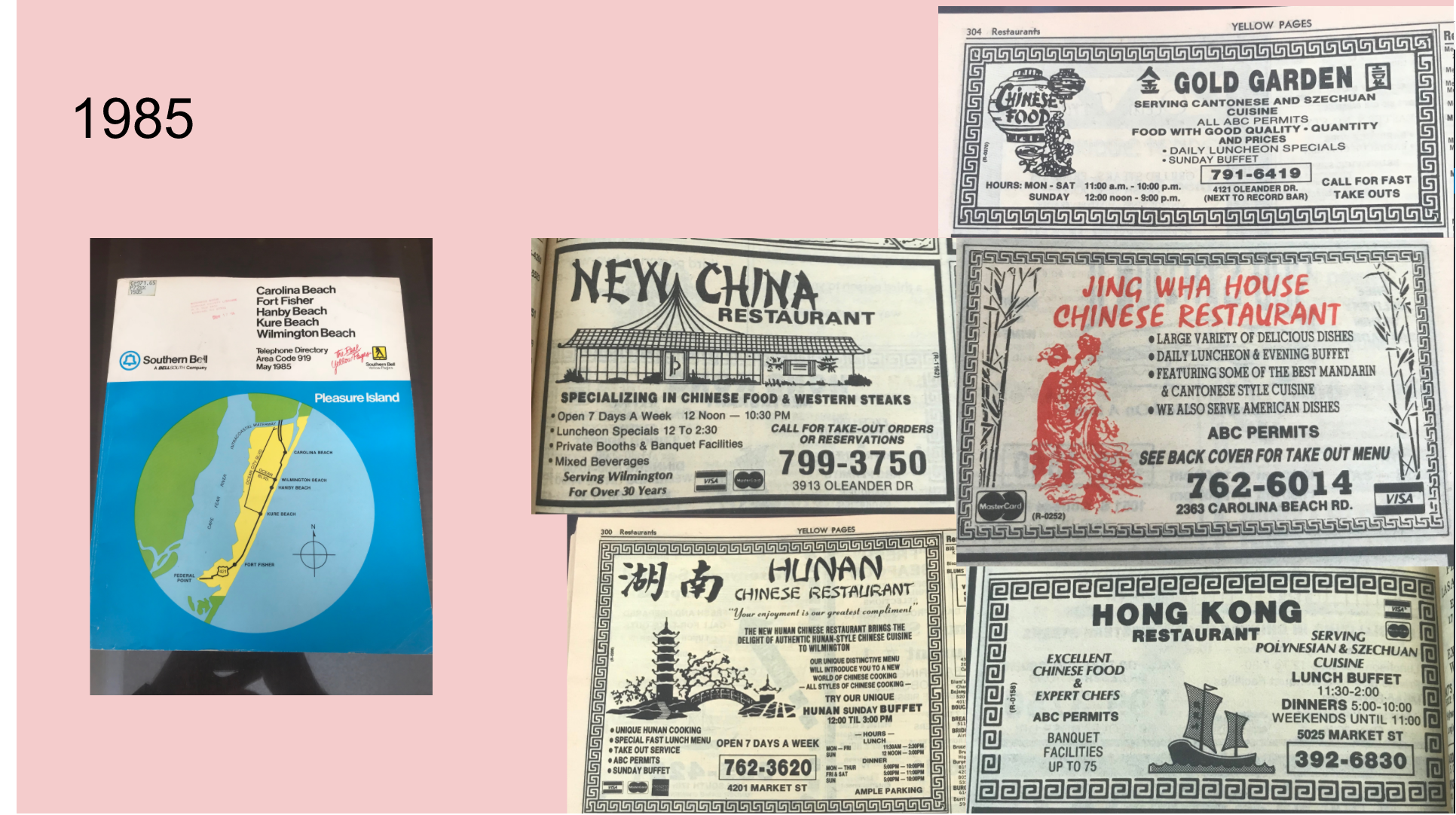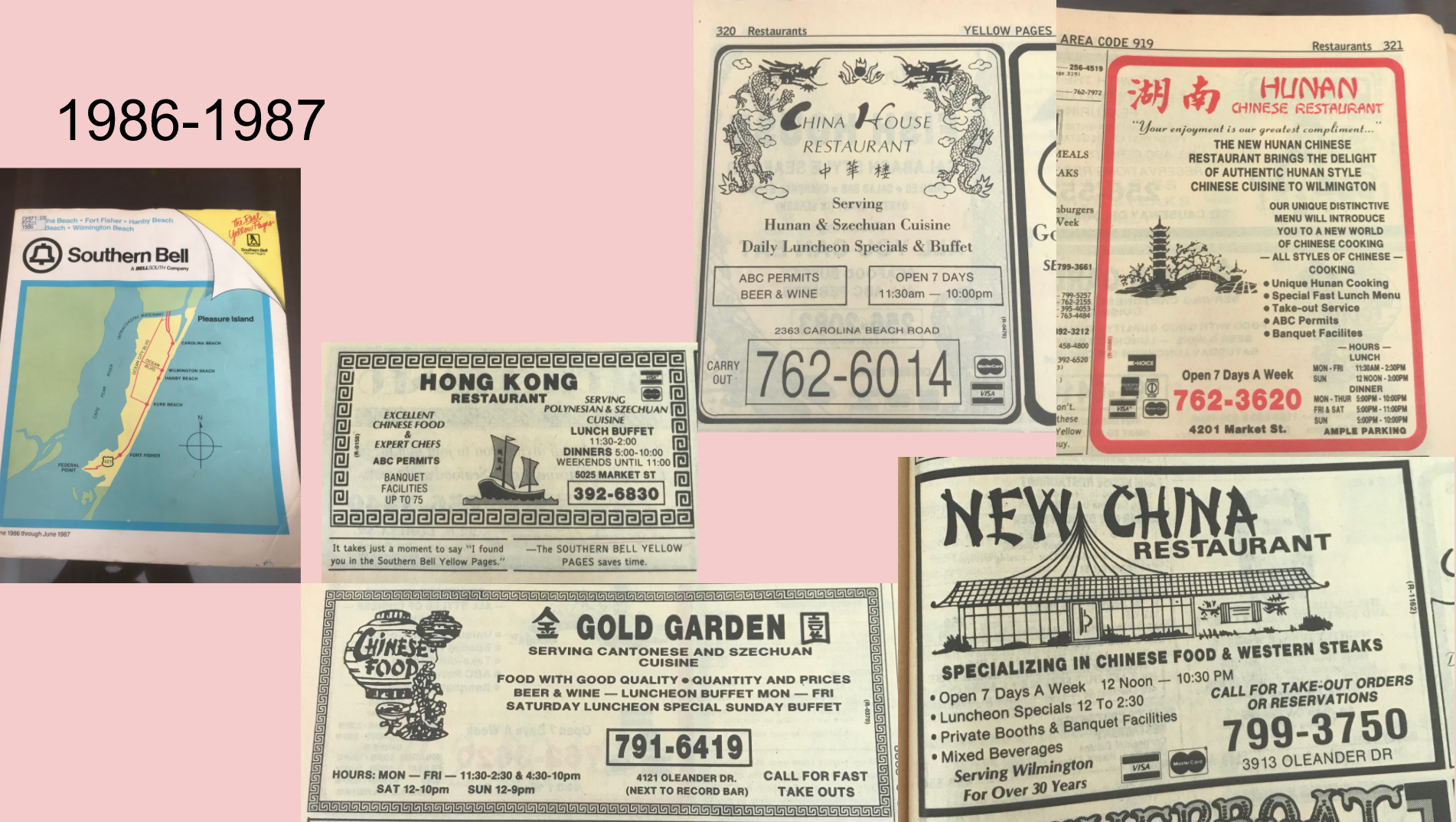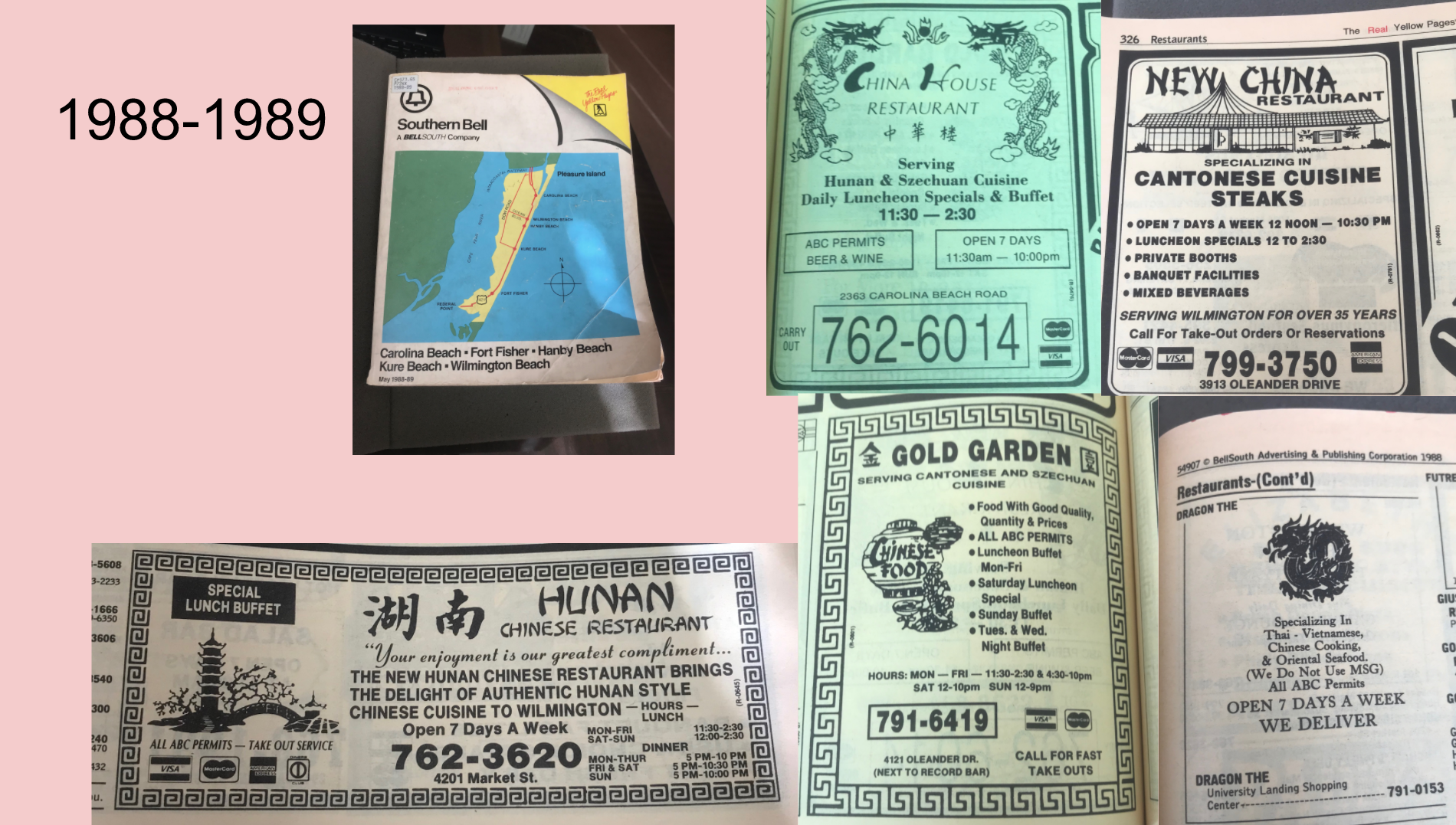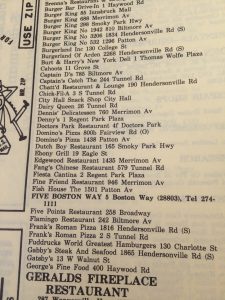1980s
North Carolina Chinese Restaurant History 1980s-1990s
Presented by: Vik Gummadi, Harris Hord, and Mackenzie Kwok
Introduction and Methodology
Our group examined city directories in the North Carolina Collection and newspaper archives from Digital NC. We chose to look at directories from Pleasure Island to reflect some of the Chinese food in the coastal region of North Carolina (and also because one of our group members is from Pleasure Island), Durham to research the Piedmont region, and Asheville for the mountain region. We searched for city directories by year and looked for keywords such as “palace” or “dragon” in business lists. We primarily focused on the restaurants’ advertisements to gauge how Chinese restaurants marketed themselves with fonts, taglines, and information they chose to convey to the public. The advertisements and placement within the city directories reflect the growing popularity of regional Chinese foods over the 1980s.
A New Wave of Chinese Immigration to the United States:
In 1977, the People’s Republic of China removed emigration restrictions on its citizens, allowing individuals to relocate to other nations without barriers. Prior to the removal of these constraints, Chinese immigration to the United States from the mainland was practically non-existent. Initially, the types of individuals making the journey over to the States were students and business professionals, but the scope of immigrants greatly diversified during the 1980s. Contrary to prior years, mainland Chinese immigrants surpassed immigrants from Taiwan and Hong Kong, and most of these migrants came to America in search of lower-status manual jobs. Many relocated to major cities like New York, which led to the development of Chinatowns in prominent urban regions. Gradually the immigrants dispersed into a variety of states, which led to the proliferation of Chinese restaurants across the country. The process of immigrating to the United States was very difficult for a large portion of these individuals, and there was a large presence of undocumented aliens who traveled to America via illegal channels.
Resources:
Barringer, Felicity. “Asian Population in U.S. Grew by 70% in the 80’s.” The New York Times, The New York Times, 2 Mar. 1990, www.nytimes.com/1990/03/02/us/asian-population-in-us-grew-by-70-in-the-80-s.html.
“Chinese Immigration to the US.” Golden Venture, www.goldenventuremovie.com/Chinese_Immigration.htm.
Skeldon, Ronald. Migration from China. www.iupui.edu/~anthkb/a104/china/chinamigration4.htm.
Zong, Jie, and Jeanne Batalova. “Chinese Immigrants in the United States.” Migration Policy Institute, 19 Oct. 2017, www.migrationpolicy.org/article/chinese-immigrants-united-states/.
Pleasure Island, NC
During the 1980s Chinese restaurants came and went in New Hanover County. The advertisements for Chinese restaurants during this time was fairly consistent. Most of the Chinese restaurants had similar styles and taglines for promoting their restaurants. There are many comparisons that can be drawn from the different Chinese restaurants’ advertisements over the years. Many of the advertisements showcase that they have ABC permits, take-out options, and are open every day of the week. Many of the Chinese restaurant advertisements from the Pleasure Island Telephone Directory also use Chinese characters and graphics that viewers would consider eastern. The wide variety of regional Chinese cuisine between the restaurants was something we made note of. Jing Wha House Chinese Restaurant promoted that it prepared Mandarin and Cantonese Cusine. Gold Garden stated that it served Cabtibese and Szechuan cuisine. Hunan Chinese Restaurant, as you might guess, promoted its Hunanese cuisine. Hong Kong Restaurant declared that it sold Polynesian and Szechuan food. China House Restaurant mentioned that it sold Hunan and Szechuan meals. The Dragon claimed to create Thai, Vietnamese, Chinese, and oriental seafood dishes. New China Restaurant was broader in not stating a specific regional Chinese affiliation in its advertisement. New Chinese Restaurant stated that it served Chinese Food and Western Steaks. Through analyzing these advertisements we can better understand what aspects of Chinese cuisine and culture were presented to those living in the United States in the 1980s.
(Click to enlarge)
Advertisements from the Pleasure Island Telephone Directories available in Wilson library from the 1980s.
Pleasure Island Telephone Directory. Southern Bell The Real Yellow Pages, 1985.
Pleasure Island Telephone Directory. Southern Bell The Real Yellow Pages, 1986/1987.
Pleasure Island Telephone Directory. Southern Bell The Real Yellow Pages, 1988/1989.
Asheville, NC
Fang’s Chinese Restaurant
Fang’s was located at 579 Tunnel Road in Asheville, North Carolina. It was advertised in the Brevard College Student Newspaper’s short write-up of suggested activities in Asheville in 1980.
In 1980, Fang’s was the only boldly advertised Chinese restaurant to appear in the Asheville City Directory. Throughout the rest of the 1980s, evidence of Fang’s remained unbolded and less noticeable.

The owner named in the City Directory is Seong D Yun. The hostess and secondary contact for Fang’s is Yun Kwang Ja. Some people in our classed thought these names were Korean, but they could also be alternate ways of spelling Chinese names during the 1980s.
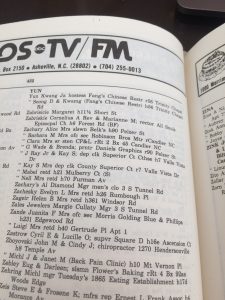
Advertisement in the Brevard College Student Newspaper
Despite being 35 miles south of Asheville, Brevard College included Fang’s in its 1980 student newspaper. Fang’s appeared in a section titled “Bars and Restaurants” in a write-up about activities to do in Asheville.
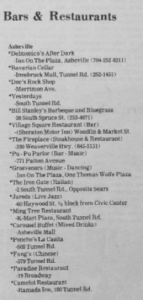
However, another Chinese restaurant makes it onto the list: Ming Tree Restaurant.
Ming Tree Restaurant
Ming Tree appeared in the Asheville City Directory in 1982, but by 1986 its presence was booming. Its president, T Fon Lee, and vice president, Roddy B Lee, advertised their restaurant in bold.
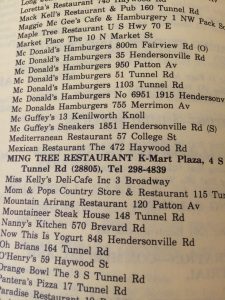
Ming Tree was located at 4 S Tunnel Road, not far from Fang’s. However, its advertising stood out much more than that of Fang’s with a large, visual advertisement in the directory. Additionally, this advertisement specifies that Ming Tree specializes in Cantonese cuisine. The drawing of the sun shining over a hut in a Chinese-like ink style alongside the bamboo font of the wording contributes to the feeling of an exotic Chinese aesthetic.
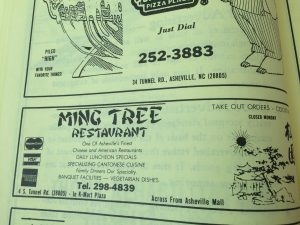
Durham, NC
China Inn Restaurant

Source: Durham City Directory 1980, Hill Directory Company Publishers
The New China Inn Restaurant is one of the first restaurants to have a featured advertisement in the Durham City Directory created by Hill Directory Company Publishers in 1980. The advertisement is placed in a prominent location atop the first page for the restaurant section in the directory. What’s surprising about this advertisement is how the restaurant promotes a variety of cuisine from different regions of China. The restaurant claims to provide dishes from the Szechuan, Hunan, Peking, and Cantonese regions. This wide variety of options is a new development for Chinese restaurants in the United States that begins primarily in the 1980s, as more entrepreneurs wish to distinguish themselves from the basic chop suey chains that have become prominent in various parts of America.
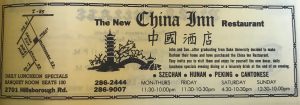
Source: Durham City Directory 1981-1982, Hill Directory Company Publishers
In the 1981-1982 version of the Durham City Directory, The New China Inn Restaurant still had a prominent advertisement on the first page for restaurants in the directory. The enterprise lost it’s place as the first restaurant shown to a pizzeria, but it still maintained a visible spot in the middle of the directory page. This version of the advertisement saw very little change from the previous year, and the only noticeable difference is the location of the restaurant’s phone number. The owners John and Sue do a great job of marketing the restaurant in the small biography provided in the middle of the advertisement. Their choice of words could help attract a wider audience because they focus on new decor, daily lunch specials, and options for leisurely drinks, all of which would appeal to a middle class white American at the time. Feel free to click on the images above to examine the advertisements more closely.
The following images are advertisements for the restaurant in the Polk Company Publishers’ versions of the city directory, taken in order, from 1983, 1986, and 1989. These versions of the ad display how the restaurant is prominently shown in the top advertisement spot on the first page for restaurants. In 1986 and 1989, the advertisement takes up almost half of the page, and includes information about how the restaurant has daily lunch specials and can be used for banquet purposes, with the capability to seat up to 100 people. Feel free to click on the images to examine them more closely.


